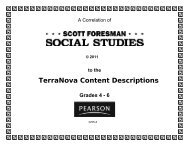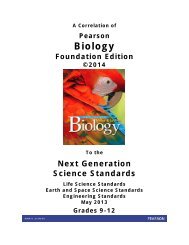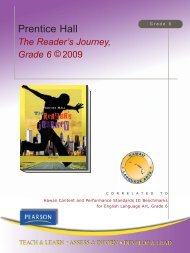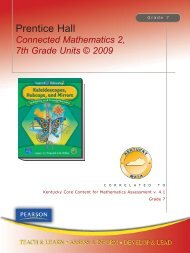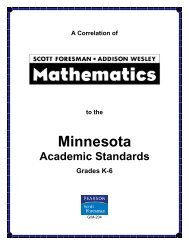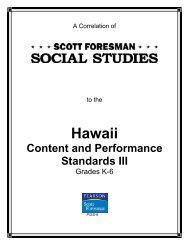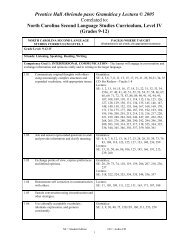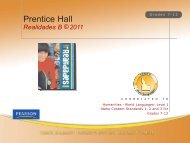A Correlation of<strong>Miller</strong> & <strong>Levine</strong> <strong>Biology</strong>, ©2014to the Next Generation Science Standards, May 2013Grades 9-12Science and Engineering PracticesDeveloping and Using ModelsModeling in 9–12 builds on K–8 experiences andprogresses to using, synthesizing, and developing modelsto predict and show how relationships among variablesbetween systems and their components in the natural anddesigned worlds.•Develop a model based on evidence to illustrate therelationships between systems or components of asystem. (HS-LS2-5)TE: Summative Performance Task (p. 88)Using Mathematics and Computational ThinkingMathematical and computational thinking in 9-12 buildson K-8 experiences and progresses to using algebraicthinking and analysis, a range of linear and nonlinearfunctions including trigonometric functions, exponentialsand logarithms, and computational tools for statisticalanalysis to analyze, represent, and model data. Simplecomputational simulations are created and used based onmathematical models of basic assumptions.•Use mathematical and/or computationalrepresentations of phenomena or design solutions tosupport explanations. (HS-LS2-1)SE: Q1 (p. 147); Q31 (p. 150)TE: Use Visuals (p. 139)•Use mathematical representations of phenomena ordesign solutions to support and revise explanations. (HS-LS2-2)SE: Case Study #2 (p. 176); Analyzing Data(p. 184)•Use mathematical representations of phenomena ordesign solutions to support claims. (HS-LS2-4)SE: Analyzing Data (p. 77); Q2 (p. 78); Q2(p. 89); Q27 and Q28 (p. 92)TE: Differentiated Instruction (p. 77)Constructing Explanations and Designing SolutionsConstructing explanations and designing solutions in 9–12builds on K–8 experiences and progresses to explanationsand designs that are supported by multiple andindependent student-generated sources of evidenceconsistent with scientific ideas, principles, and theories.•Construct and revise an explanation based on validand reliable evidence obtained from a variety of sources(including students’ own investigations, models, theories,simulations, peer review) and the assumption thattheories and laws that describe the natural world operatetoday as they did in the past and will continue to do so inthe future. (HS-LS2-3)SE: Q13 (p. 90); Chapter 9 Mystery (pp. 249and 269)•Design, evaluate, and refine a solution to a complexreal-world problem, based on scientific knowledge,student-generated sources of evidence, prioritized criteria,and tradeoff considerations. (HS-LS2-7)Disciplinary Core IdeasLS2.A: Interdependent Relationships inEcosystems•Ecosystems have carrying capacities, which are limitsto the numbers of organisms and populations they cansupport. These limits result from such factors as theavailability of living and nonliving resources and from suchchallenges such as predation, competition, and disease.Organisms would have the capacity to producepopulations of great size were it not for the fact thatenvironments and resources are finite. This fundamentaltension affects the abundance (number of individuals) ofspecies in any given ecosystem. (HS-LS2-1),(HS-LS2-2)SE/TE: Competition (pp. 100–101);Exponential Growth (pp. 132–133); LogisticGrowth (pp. 134–135); Density-DependentLimiting Factors (pp. 138–140)LS2.B: Cycles of Matter and Energy Transfer inEcosystems•Photosynthesis and cellular respiration (includinganaerobic processes) provide most of the energy for lifeprocesses. (HS-LS2-3)SE/TE: Primary Producers (pp. 69–70);Energy and Life (pp. 226–228); ChemicalEnergy and Food (p. 250)•Plants or algae form the lowest level of the food web.At each link upward in a food web, only a small fraction ofthe matter consumed at the lower level is transferredupward, to produce growth and release energy in cellularrespiration at the higher level. Given this inefficiency,there are generally fewer organisms at higher levels of afood web. Some matter reacts to release energy for lifefunctions, some matter is stored in newly madestructures, and much is discarded. The chemical elementsthat make up the molecules of organisms pass throughfood webs and into and out of the atmosphere and soil,and they are combined and recombined in different ways.At each link in an ecosystem, matter and energy areconserved. (HS-LS2-4)SE/TE: Food Chains and Food Webs (pp.73–75); Trophic Levels and EcologicalPyramids (pp. 77–78); Recycling in theBiosphere (pp. 79–80); Nutrient Cycles (pp.82–85)•Photosynthesis and cellular respiration are importantcomponents of the carbon cycle, in which carbon isexchanged among the biosphere, atmosphere, oceans,and geosphere through chemical, physical, geological, andbiological processes. (HS-LS2-5)SE/TE: The Carbon Cycle (pp. 82–83)Crosscutting ConceptsCause and Effect•Empirical evidence is required to differentiate betweencause and correlation and make claims about specificcauses and effects. (HS-LS2-8)TE: How Science Works (p. 848)<strong>Biology</strong>.com: Chapter 29 STEM activity,Yellowstone WolvesScale, Proportion, and Quantity•The significance of a phenomenon is dependent on thescale, proportion, and quantity at which it occurs. (HS-LS2-1)SE: Analyzing Data (p. 150)TE: Connect to Math (p. 143)<strong>Biology</strong>.com: Chapter 3 Data Analysis,Counting on Nature•Using the concept of orders of magnitude allows oneto understand how a model at one scale relates to amodel at another scale. (HS-LS2-2)TE: Connect to Math (p. 133)Systems and System Models•Models (e.g., physical, mathematical, computermodels) can be used to simulate systems andinteractions—including energy, matter, and informationflows—within and between systems at different scales.(HS-LS2-5)SE: Figure 3–17 (p. 83)TE: Transfer Performance Task (p. 242)Energy and Matter•Energy cannot be created or destroyed—it only movesbetween one place and another place, between objectsand/or fields, or between systems. (HS-LS2-4)SE: Figure 3–5 (p. 70); Figure 3–6 (p. 71);Figure 3–11 (p. 77)TE: Address Misconceptions (p. 70); AddressMisconceptions (p. 82)•Energy drives the cycling of matter within and betweensystems. (HS-LS2-3)SE: Visual Analogy (p. 79); Q 26 (p. 92)TE: Build Background (p. 69); Quick Facts(p. 70)SE: Quick Lab (p. 155); Analyzing Data(p. 172); Q4 (p. 181); Unit 2 Project (pp.61a–61b)SE = Student Edition; TE = Teacher’s Edition; LMA = Lab Manual A 10
A Correlation of<strong>Miller</strong> & <strong>Levine</strong> <strong>Biology</strong>, ©2014to the Next Generation Science Standards, May 2013Grades 9-12TE: Transfer Performance Task (p. 122)Engaging in Argument from EvidenceEngaging in argument from evidence in 9–12 builds on K–8 experiences and progresses to using appropriate andsufficient evidence and scientific reasoning to defend andcritique claims and explanations about the natural anddesigned world(s). Arguments may also come fromcurrent scientific or historical episodes in science.•Evaluate the claims, evidence, and reasoning behindcurrently accepted explanations or solutions to determinethe merits of arguments. (HS-LS2-6)SE: Analyzing Data, p. 102; Quick Lab, p.108; Q2 (p. 147)•Evaluate the evidence behind currently acceptedexplanations to determine the merits of arguments. (HS-LS2-8)SE: Q30 (p. 856)<strong>Biology</strong>.com: Chapter 29 STEM activity-------------------------------------------------------Connections to Nature of ScienceScientific Knowledge is Open to Revision in Light ofNew Evidence•Most scientific knowledge is quite durable, but is, inprinciple, subject to change based on new evidenceand/or reinterpretation of existing evidence. (HS-LS2-2),(HS-LS2-3)SE: Chapter 3 Mystery (pp. 63 and 91);Chapter 4 Mystery (pp. 95 and 125)TE: How Science Works (p. 100)•Scientific argumentation is a mode of logical discourseused to clarify the strength of relationships between ideasand evidence that may result in revision of anexplanation. (HS-LS2-6),(HS-LS2-8)SE: Chapter 5 Mystery (pp. 129 and 149);Chapter 29 Mystery (pp. 839 and 855)TE: Lead a Discussion (p. 108); AddressMisconceptions (p. 109); How Science Works(p. 539)LS2.C: Ecosystem Dynamics, Functioning, andResilience•A complex set of interactions within an ecosystem cankeep its numbers and types of organisms relativelyconstant over long periods of time under stableconditions. If a modest biological or physical disturbanceto an ecosystem occurs, it may return to its more or lessoriginal status (i.e., the ecosystem is resilient), asopposed to becoming a very different ecosystem. Extremefluctuations in conditions or the size of any population,however, can challenge the functioning of ecosystems interms of resources and habitat availability. (HS-LS2-2),(HS-LS2-6)SE/TE: Primary and Secondary Succession(pp. 106–107); Climax Communities (pp.108–109)•Moreover, anthropogenic changes (induced by humanactivity) in the environment—including habitatdestruction, pollution, introduction of invasive species,overexploitation, and climate change—can disrupt anecosystem and threaten the survival of some species.(HS-LS2-7)SE/TE: What Can Be Done About InvasiveMussels? (p. 136); The Effect of HumanActivity (pp. 154–156); Soil Erosion (p. 159);Water Pollution (pp. 160–162); Air Pollution(pp. 163–164); Air Quality and Sustainability(p. 165); Altered Habitats (p. 168)LS2.D: Social Interactions and Group Behavior•Group behavior has evolved because membership canincrease the chances of survival for individuals and theirgenetic relatives. (HS-LS2-8)SE/TE: Behavioral Cycles (p. 845); SocialBehavior (pp. 848–849); Communication (pp.850–851)LS4.D: Biodiversity and Humans•Biodiversity is increased by the formation of newspecies (speciation) and decreased by the loss of species(extinction). (secondary to HS-LS2-7)SE/TE: The Process of Speciation (pp. 494–497); Speciation and Extinction (pp. 546–548)•Humans depend on the living world for the resourcesand other benefits provided by biodiversity. But humanactivity is also having adverse impacts on biodiversitythrough overpopulation, overexploitation, habitatdestruction, pollution, introduction of invasive species,and climate change. Thus sustaining biodiversity so thatecosystem functioning and productivity are maintained isessential to supporting and enhancing life on Earth.Sustaining biodiversity also aids humanity by preservinglandscapes of recreational or inspirational value.(secondary to HS-LS2-7) (Note: This Disciplinary CoreIdea is also addressed by HS-LS4-6.)SE/TE: The Value of Biodiversity (pp. 166–167); Threats to Biodiversity (pp. 168–170);Conserving Biodiversity (pp. 170–171);Ecology in Action (pp. 174–179)Stability and Change•Much of science deals with constructing explanationsof how things change and how they remain stable. (HS-LS2-6),(HS-LS2-7)SE: Q2 (p. 123); Q18 (p. 124); AnalyzingData (p. 126); Q3 (p. 179); Chapter Mystery(p. 183)TE: Build Background (p. 69); Quick Facts(p. 70); How Science Works (p. 106);Differentiated Instruction (p. 108); UseVisuals (p. 176)<strong>Biology</strong>.com: Virtual Lab, Introduction toEcologySE = Student Edition; TE = Teacher’s Edition; LMA = Lab Manual A 11



